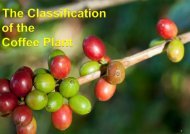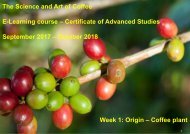Create successful ePaper yourself
Turn your PDF publications into a flip-book with our unique Google optimized e-Paper software.
Several traits can be exploited to classify <strong>plant</strong>s, and traditional ones are based on <strong>plant</strong> morphology, which<br />
studies <strong>the</strong> <strong>plant</strong> form and <strong>the</strong>ir specific structural features. Here, botanists distinguish vegetative traits like <strong>the</strong><br />
appearance <strong>of</strong> <strong>the</strong> leaves (C<strong>of</strong>fea: leaves with smooth margins and <strong>the</strong> shape is elliptic-ovate to oblong), <strong>plant</strong><br />
growth = habitus (C<strong>of</strong>fea: shrub or a small tree), phyllotaxy (C<strong>of</strong>fea: opposite growth, where two leaves attach at<br />
each point (node) on <strong>the</strong> branch), branching pattern <strong>of</strong> a tree (C<strong>of</strong>fea: opposite again) or specific structures <strong>of</strong> <strong>the</strong><br />
stem (no specific trait for C<strong>of</strong>fea). Next, an important source <strong>of</strong> information lies in <strong>the</strong> morphology <strong>of</strong> <strong>the</strong> flowers.<br />
As those traits are <strong>of</strong> reproductive importance, already small deviations from <strong>the</strong> mean could have an immediate<br />
effect on forming new species. Here, structure (C<strong>of</strong>fea: white flowers, radial symmetry (identical parts are<br />
arranged in a circular fashion around a central axis), 5 petals (modified leaves that surround <strong>the</strong> reproductive<br />
parts, <strong>of</strong>ten coloured to attract pollination) that form a tube (<strong>the</strong> base <strong>of</strong> <strong>the</strong> petals are fused) and <strong>the</strong> actual<br />
appearance as inflorescence (C<strong>of</strong>fea : flowers grow in clusters (= inflorescence) in <strong>the</strong> axils <strong>of</strong> <strong>the</strong> leaves) as well<br />
as <strong>the</strong> resulting fruits (C<strong>of</strong>fea: red drupe in <strong>the</strong> size <strong>of</strong> a cherry that contains usually two seeds) are important.<br />
Next to morphology also ecology can give hints on <strong>the</strong> relationship <strong>of</strong> a species. Or that closely related species<br />
share certain secondary <strong>plant</strong> metabolites, which serve a certain purpose in <strong>the</strong> <strong>plant</strong>, e.g. nicotine was invented<br />
for defense purposes. The resulting taxonomy is <strong>the</strong>refore also called chemotaxonomy, which is in turn closely<br />
related to biochemical analyses <strong>of</strong> <strong>the</strong> metabolism <strong>of</strong> <strong>the</strong> <strong>plant</strong> that is also similar among closely related species.<br />
Embryology could be used, where <strong>the</strong> development <strong>of</strong> <strong>the</strong> embryo is used to study its origin. Fossil botany in turn<br />
is used to judge <strong>the</strong> age <strong>of</strong> a trait. If a certain trait was already present in fossils this trait (symplesiomorph) has<br />
been developed a long time ago and is likely shared by many species, compared to a ra<strong>the</strong>r new trait (apomorph)<br />
that has originated only recently based on an “invention”.<br />
More recently, genetic analyses or molecular methods in general are becoming more and more relevant in<br />
determining <strong>the</strong> classification <strong>of</strong> life on earth, e.g. <strong>the</strong> already mentioned new classification <strong>of</strong> angiosperms by <strong>the</strong><br />
APG was based <strong>of</strong> DNA sequencing.<br />
23








